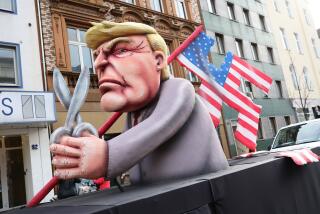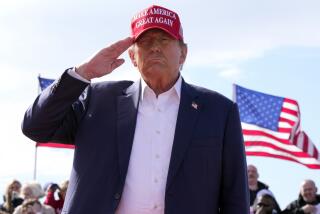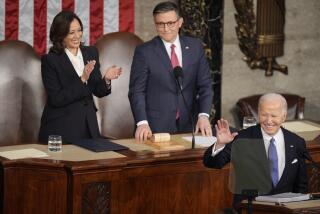One year in, Trump tries to define his national security strategy to fit his ‘America first’ vision

President Trump has found it much easier to say “America first” than to fit the nationalist slogan into actual national security strategy. Now, nearly a year into his term, he is seeking to define his vision — often articulated in impulsive tweets — in a comprehensive overview.
The president will deliver a speech on Monday distilling a lengthy strategy document that has been months in the making. During a Cabinet-level meeting this month, he signed off on an approximately 70-page draft that his national security advisor, H.R. McMaster, summarized by another slogan, Ronald Reagan’s: “Peace through strength.”
The plan will focus on projecting U.S. military and economic strength overseas, McMaster said at a Washington think tank on Tuesday, with a particular emphasis on countering major powers China and Russia and containing nuclear threats from Iran and North Korea.
“In many ways, we vacated a lot of competitive space in recent years and created opportunities for these revisionist powers,” McMaster said.
That critique of past presidents could better be said of Trump’s performance to date, according to his critics, who include veterans of past Republican administrations. They complain that Trump has ceded leadership around the globe, economically and diplomatically, opening opportunities especially for China and Russia and raising tensions with Iran and North Korea, as well as with longtime allies.
Increasingly, the critics lament that Trump has demoted diplomacy and undermined the work of the State Department, creating skepticism in international capitals about the United States’ reliability.
“He made the situation worse by cutting the State Department,” said Rep. Seth Moulton of Massachusetts, a Democrat on the House Armed Services Committee who served four tours as a Marine officer in Iraq.
“He’s not putting America first, he’s weakening national security with erratic tweets and threatening nuclear war,” Moulton said.
Trump’s national security strategy has been in the works since March, with White House officials working to translate his nationalist and populist campaign promises and 140-character tweets into a coherent, wide-ranging guide for the military, diplomatic corps and intelligence agencies.
Since Reagan, administrations have chosen to write such a strategic plan about once every four years; the most recent was President Obama’s in February 2015. Trump’s draft was structured around four main pillars: protecting the homeland through tightening immigration, advancing American economic prosperity by pressuring China and other trading partners, projecting hard power by building up the military and increasing American influence.
“It is a major signaling document, filling in the blanks for the bureaucracy and putting a clear narrative behind Trump’s campaign promises,” said Michael Allen, who served on President George W. Bush’s National Security Council and has advised the Trump team.
Most sweeping white papers often are soon forgotten or widely ignored. But Trump’s version may have a stronger influence on policy decisions given that his inner circle is stacked with senior military leaders — McMaster, a three-star Army general, and two retired Marine Corps generals, White House Chief of Staff John F. Kelly and Defense Secretary James N. Mattis — who are accustomed to applying broad strategic guidelines to real-world decisions.
McMaster oversaw the national security strategy, along with his departing deputy, Dina Powell. The document was written by Nadia Schadlow, a former academic whose expertise is competition between great powers. Schadlow met with Trump personally during the drafting and now is on a short list of people who could succeed Powell.
Another reason that some officials see added benefit — and longer shelf life — with this strategy document is that it has been written for the only president to take office with neither military nor governing experience. The exercise has forced a focus and discipline on Trump’s thinking that could — officials hope — reduce the episodes in which he feels boxed in between his campaign promises and advisors’ policy recommendations.
It’s become an uncomfortable running joke among Trump’s senior national security advisors: Whose turn is it to walk into the buzz saw?
An Oval Office meeting in mid-July showed the danger of asking the president to do something he doesn’t want to do.
Trump had campaigned on tearing up the multinational nuclear deal with Iran that the Obama administration had brokered, and he faced a deadline to certify to Congress that Iran was in compliance. Advisors, including Secretary of State Rex Tillerson and McMaster, favored certification and had to repeatedly tell the president they hadn’t prepared other options to consider, and would have to warn allies if Trump was about to reverse course.
Trump exploded, within earshot of more than a half-dozen senior advisors.
“This is never ... happening again,” Trump said, using an expletive, according to two people, one who heard him and another who was briefed on the meeting. Neither would be identified discussing internal deliberations.
He reluctantly agreed to keep the deal in place. But in October, when the certification deadline came up again, Trump demanded a compromise plan to tell Congress to fix the deal or he’d end it himself.
Trump faces another difficult deadline on the Iran deal in mid-January. That’s when waivers expire that currently hold back U.S. sanctions against Iran. This deadline puts Trump in the uncomfortable position of choosing whether to keep the sanctions at bay, in accordance with the deal, when he’s told Congress he thinks sanctions relief is inappropriate.
In August, Trump’s dilemma was over U.S. troop levels in Afghanistan. He had once backed withdrawing from Afghanistan and campaigned on getting the U.S. out of foreign wars. His military advisors, including Mattis and McMaster, wanted him to authorize 50,000 troops to shore up the government in Kabul. Trump balked. His chief strategist at the time, Stephen K. Bannon, was pushing for a minimal number of troops and more armed contractors. Trump signed off on a comparatively modest boost from about 8,400 troops to about 12,400 — still a 50% increase.
“My original instinct was to pull out,” Trump said at the time. “But all of my life I heard that decisions are much different when you sit behind the desk in the Oval Office.”
Trump has rankled career diplomats and intelligence officials from the start by repeatedly complimenting Russian President Vladimir Putin. Despite the special counsel investigation into whether the Trump campaign colluded with Russia to win the White House, he refuses to give up on a hope he can bond with Putin and convince the Russian leader to do more to counter the Islamic State militant group and North Korea.
The intelligence community, however, has been on high alert over Moscow’s advances in projecting power into Eastern Europe, hacking into U.S. government computers and undermining public trust in elections not only in the United States but in Europe.
When Trump called Putin on Thursday night, they talked about none of that, according to cryptic statements from both the White House and Kremlin. Instead, Trump thanked the Russian autocrat for praising America’s strong economic performance during his annual news conference.
Twitter: @ByBrianBennett
More to Read
Get the L.A. Times Politics newsletter
Deeply reported insights into legislation, politics and policy from Sacramento, Washington and beyond. In your inbox three times per week.
You may occasionally receive promotional content from the Los Angeles Times.







